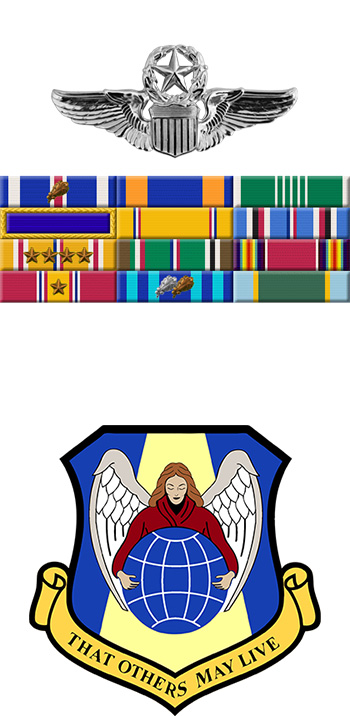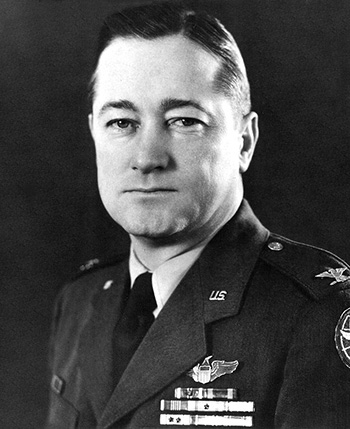
|
Richard T. Kight |
 |
|||
| Rank, Service | ||||
Brigadier General O-7, U.S. Air Force |
||||
| Veteran of: | ||||
|
||||
| Tribute: | ||||
Richard Kight was born on October 18, 1913, in Collinsville, Texas. He enlisted in the Texas Army National Guard on October 2, 1932, and served with the 131st Field Artillery until July 10, 1933. He then enlisted in the Army Air Corps on December 9, 1933, and entered the Aviation Cadet Program of the Air Corps on October 12, 1934, earning his pilot wings at Kelly Field, Texas, on October 14, 1935. He remained as a Flying Cadet until receiving his commission as a 2d Lt in the Air Corps on October 15, 1936, and then served with the 7th Bomb Group at Hamilton Field, California, until leaving active duty and joining the Army Reserve on December 26, 1936. After flying as a commercial airline pilot with United Air Lines, Lt Kight was recalled to active duty on March 28, 1938, and served as an Operations Officer and B-10 and B-18 Bolo Flight Commander with the 96th Bomb Squadron of the 2nd Bomb Group at Langley Field, Virginia, from March 1938 to May 1940. His next assignment was as a B-18 and B-17 Flying Fortress pilot and Operations Officer with the 34th Bomb Group at Westover Field, Massachusetts, from May 1940 to September 1941, followed by service as a Special Flights pilot with the Army Air Corps Ferry Command from September 1941 to December 1942. Col Kight served as Operations Officer and Executive Officer with Headquarters India-China Wing at Chabua and then New Delhi, India, where he flew missions and served as Chief of Staff and Director of Operations for the Hump operations from December 1942 to January 1944. His next assignment was as Commanding Officer of the 1103rd Base Unit at Morrison Field, Florida, from January 1944 to November 1945, and he then served as Commanding Officer of the 1537th Base Unit on Guam from November 1945 to October 1946. Col Kight served as Commanding Officer of the Air Rescue Service at Morrison Field from December 1946 to July 1947, at MacDill Field, Florida, from July to December 1947, and at the Pentagon from December 1947 to August 1952. He attended Air War College at Maxwell AFB, Alabama, from August 1952 to July 1953, and then served as Commander of the 1500th Air Base Wing at Hickam AFB, Hawaii, from August 1953 to October 1954. He next served as Inspector General for Headquarters Combat Crew Training Air Force at Randolph AFB, Texas, from November 1954 to April 1956, followed by F-86D Sabre Combat Crew Training from April to June 1956. Gen Kight served as Commander of the 3625th Combat Crew Training Wing at Tyndall AFB, Florida, from June 1956 to June 1957, followed by service as Vice Commander and then Commander of the 34th Air Division at Kirtland AFB, New Mexico, from July 1957 to November 1959. He served as Vice Commander of the Central Air Defense Force at Richards-Gebaur AFB, Missouri, from November to December 1959, and as Vice Commander of the 33rd Air Division at Richards-Gebaur from January to May 1960. He next served as Commander of the Los Angeles Air Defense Sector at Norton AFB, California, from May 1960 to July 1961, followed by service as Chief of Staff and then Principal Air Staff Officer with Headquarters Allied Air Forces Northern Europe in Oslo, Norway, from July 1961 to June 1963. He served as Deputy Commander of the 5th Allied Tactical Air Force in Vicenza, Italy, from July 1963 to August 1965, and then as the Supreme Allied Commander Europe Representative to the Joint Strategic Target Planning Staff at Louveciennes, France, from August 1965 until his retirement from the Air Force on September 1, 1967. Richard Kight died on June 17, 2001, and was buried at the Santa Fe National Cemetery in Santa Fe, New Mexico. While serving as the Commander of the Air Rescue Service, Col Kight directed its development and expansion and introduced many present day rescue techniques. He also personally performed much of the testing of rescue equipment and employment techniques, and he wrote the The Code of the Air Rescueman (which was later borrowed by the PJs and made into the Pararescue Creed): "It is my duty as an Air Rescueman to save lives and to aid the injured. I will be prepared at all times to perform my assigned duties quickly and efficiently, placing these duties before personal desires and comforts. These things I do, that others may live." |
||||
|
||||

